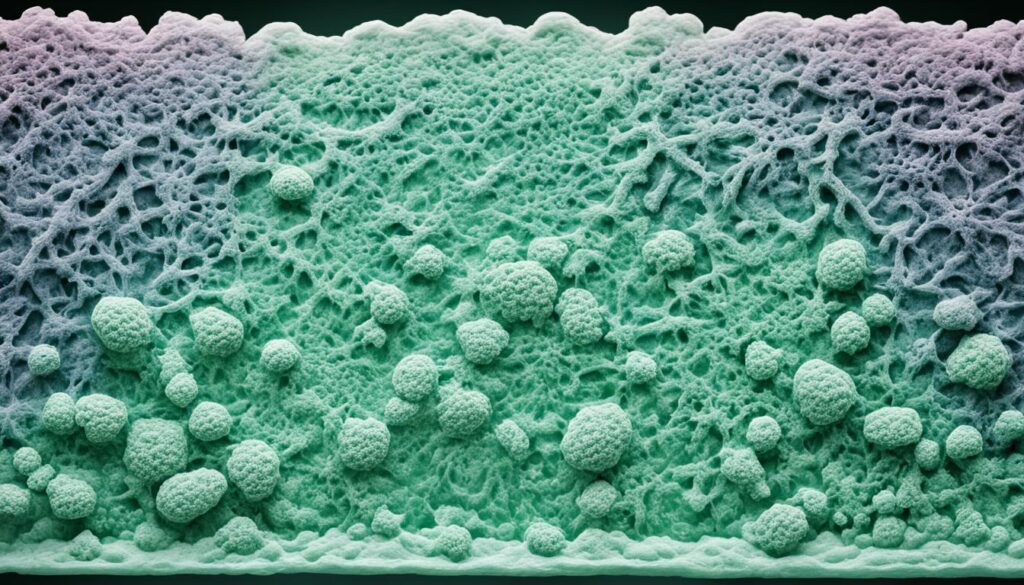
Mold Ingestion Symptoms: Recognize the Risks
Welcome to our informative guide on the symptoms associated with mold ingestion and the importance of recognizing the risks. Mold is a common problem that can be found in various environments, including homes, offices, and public spaces. While mold may seem harmless, it can have serious health implications when ingested.
Mold ingestion occurs when individuals unknowingly consume food or drinks contaminated with mold spores. These microscopic particles can trigger a range of symptoms, affecting both physical and respiratory health. It is crucial to be aware of these symptoms to ensure timely intervention and minimize potential health risks.
Key Takeaways:
- Understanding the symptoms of mold ingestion is vital for early identification and appropriate action.
- Mold ingestion can lead to various health issues, including respiratory problems and allergic reactions.
- Common symptoms of mold ingestion include coughing, sneezing, wheezing, headaches, and fatigue.
- Preventing mold growth and taking proactive measures to eliminate mold sources are essential for reducing the risk of ingestion.
- If you suspect mold exposure or experience unexplained symptoms, consult a healthcare professional for evaluation and advice.
What is Mold Ingestion?
Mold ingestion refers to the process of consuming or ingesting mold-contaminated substances. It can occur when individuals unknowingly consume food or beverages that contain mold or when they inhale mold spores that have settled on food or other surfaces. Mold can be found in various environments, including homes, offices, schools, and outdoor areas.

Mold thrives in damp and humid conditions and can grow on a variety of organic materials, such as wood, paper, fabric, and food. It reproduces by releasing tiny spores into the air, which can easily be inhaled or ingested.
When mold is ingested, it can have various health consequences. Some individuals may experience allergic reactions, such as coughing, sneezing, and wheezing. Others may develop more severe symptoms, including respiratory problems, headaches, fatigue, and digestive issues.
“Ingesting mold can have detrimental effects on our health, especially for individuals who are sensitive or allergic to mold. It’s important to be aware of the potential risks and take preventive measures to minimize exposure.”
Ingesting certain types of mold can also lead to mycotoxicosis, which is a condition caused by the toxins produced by certain molds. Mycotoxicosis can result in a range of symptoms, including neurological issues, immune system disruptions, and organ damage.
Common Sources of Mold
Mold can be found in various places, and it’s important to identify and address potential sources to prevent ingestion. Here are some common sources of mold:
- Damp or humid environments, such as basements, bathrooms, and kitchens.
- Water-damaged buildings, including those affected by flooding or leaks.
- Poorly ventilated areas with limited airflow.
- Old or decaying organic matter, such as rotten food or compost.
- Mold-contaminated food and beverages.
Health Consequences of Mold Ingestion
When mold is ingested, it can have various health consequences, depending on the individual’s sensitivity and the type of mold involved. Some common health effects of mold ingestion include:
- Allergic reactions, such as nasal congestion, sneezing, and skin rashes.
- Respiratory problems, including coughing, wheezing, and shortness of breath.
- Headaches, fatigue, and difficulty concentrating.
- Digestive issues, such as nausea, vomiting, and diarrhea.
- Mycotoxicosis, which can cause neurological symptoms, immune system disruption, and organ damage.
It’s important to seek medical attention if you experience persistent or severe symptoms after ingesting mold. A healthcare professional can provide a proper diagnosis and recommend appropriate treatment options.
Common Mold Ingestion Symptoms
When it comes to mold ingestion, understanding the common symptoms is crucial for early detection and intervention. The manifestation of symptoms can vary depending on an individual’s sensitivity to mold and the type of mold involved. By recognizing these symptoms, you can take appropriate action to address any potential health concerns.
Here are some of the most commonly reported symptoms associated with mold ingestion:
- Allergic reactions: These may include sneezing, coughing, watery eyes, and nasal congestion. In some cases, skin rashes or itchiness may also occur.
- Respiratory issues: Persistent coughing, wheezing, shortness of breath, or difficulty breathing can be indicative of mold-related respiratory problems.
- Headaches and migraines: Mold exposure has been linked to the onset or worsening of headaches and migraines in some individuals.
- Fatigue and weakness: Feeling constantly tired, lacking energy, or experiencing unexplained weakness may be a sign of mold ingestion.
- Digestive problems: Nausea, diarrhea, abdominal pain, and other gastrointestinal issues can occur as a result of ingesting mold-contaminated food or water.
- Neurological symptoms: Some people may experience neurological symptoms such as dizziness, difficulty concentrating, memory problems, or mood changes.
If you or someone you know is experiencing these symptoms and suspects mold ingestion as the cause, it is essential to consult a healthcare professional for an accurate diagnosis and appropriate treatment. Identifying the source of mold exposure and taking steps to eliminate it from your living environment can also help prevent further health issues.
“Recognizing the common symptoms of mold ingestion is the first step towards protecting your health and well-being. Don’t ignore the signs, as early intervention can make a significant difference in preventing chronic health problems.”
To provide a clear picture of the symptoms associated with mold ingestion, here’s a comprehensive table outlining their common manifestations:
| Symptoms | Description |
|---|---|
| Allergic reactions | Sneezing, coughing, watery eyes, nasal congestion, skin rashes, itchiness |
| Respiratory issues | Coughing, wheezing, shortness of breath, difficulty breathing |
| Headaches and migraines | Onset or worsening of headaches and migraines |
| Fatigue and weakness | Constant tiredness, lack of energy, unexplained weakness |
| Digestive problems | Nausea, diarrhea, abdominal pain, gastrointestinal issues |
| Neurological symptoms | Dizziness, difficulty concentrating, memory problems, mood changes |

Prevention and Treatment of Mold Ingestion
Preventing mold ingestion is crucial for maintaining a healthy living environment. The first step in prevention is to identify and address any existing mold sources. Regularly inspect your home for areas prone to moisture, such as bathrooms, kitchens, and basements. Keep these areas dry and well-ventilated to discourage mold growth.
To further reduce the risk of mold ingestion, ensure proper drainage around your home’s foundation and fix any leaks promptly. Use mold-resistant building materials and consider installing a dehumidifier if necessary. It is also important to clean and dry any water-damaged items or building materials within 24 to 48 hours to prevent mold growth.
If you suspect mold ingestion or experience related health issues, it is crucial to seek appropriate treatment. While mild symptoms may improve with over-the-counter antihistamines or nasal sprays, it is advisable to consult a healthcare professional for a proper diagnosis and treatment plan.
In severe cases, where mold exposure leads to chronic health conditions, such as allergies, asthma, or respiratory infections, more comprehensive treatments may be necessary. These may include prescription medications, immunotherapy, or lifestyle changes to minimize exposure to mold and other allergens.




